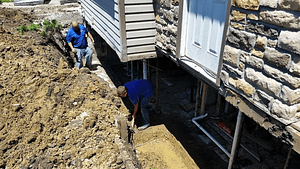What Does Best Basement Waterproofing Do?
What Does Best Basement Waterproofing Do?
Blog Article
An Unbiased View of Best Basement Waterproofing
Table of ContentsAn Unbiased View of Best Basement WaterproofingThe smart Trick of Best Basement Waterproofing That Nobody is Talking AboutSome Of Best Basement WaterproofingBest Basement Waterproofing - The FactsBest Basement Waterproofing Can Be Fun For Everyone
uses excavation methods toward all-time low of the framework's structure. entails eliminating wetness after it has actually entered the cellar. AdvantaClean's trained specialists and technicians will certainly locate the water source. If wall or piece fractures exist, we will certainly infuse polyurethane and epoxies into the splits and secure the compromise, preventing additional moisture from getting in.
If there's condensation on the outside of the aluminum foil, you have high moisture in your cellar. Fix it with a mobile space dehumidifier or a whole-house humidifier system rather than waterproofing products. If the aluminum foil has condensation on the inside surface (next to the wall surface), the soil around your house may be naturally damp from a high water table or poor soil water drainage.
You can waterproof just your indoor wall surfaces, which might solve the trouble. Once they dry, they adhere permanently to concrete and masonry wall surfaces.
About Best Basement Waterproofing
Concrete waterproof finishings can not be used to formerly painted surfaces; inspect the label. Known as densifiers, they are appropriate just for wall surfaces that have not been painted or sealed.
Yet you comb, roll, or spray it on a lot even more heavily one gallon covers just 75 square feet, not the 300 square feet normal with standard paint. Waterproof paint is great for DIY application. You can apply it over repainted surface areas, and paint over it once it's healed (one gallon costs $37).
It can set you back $10,000 to $15,000, depending on the job required. Outside waterproofing involves digging deep into all around the house fully deepness of the structure walls, then installing a water-proof finishing or membrane topped by drainage panels. The panels give an easy course for water to stream to an external French drain at the bottom of your foundation.
A cellar without waterproofing is kind of like that. Your cellar does not want to go through a downpour without correct protection just as much as you do not want to.
Some Of Best Basement Waterproofing
However if you've done your research study, you would certainly understand there are 2 sorts of waterproofing: inside and outside. It can get puzzling what they both mean, which one's a much better investment, and what will in fact maintain the water out. Do not fret, we placed together this blog site to easily specify both approaches for you and go over the benefits and drawbacks of each.
Exterior waterproofing is a waterproofing approach that involves securing your home from the exterior. It's kind of like a moat around a castle. It entails digging a trench around your whole residence informative post down to the foundation (concerning 8 to 10 feet down). The structure walls are after that cleaned, secured, and covered with a waterproof membrane or sealer.

Fascination About Best Basement Waterproofing
It's an extra involved procedure that requires digging up your find more backyard, which is costly and taxing. Exterior waterproofing involves removing every little thing bordering the house, consisting of decks, driveways, pathways, landscaping, air conditioner units, decks, and so on. If any of the work was done inaccurately and water is still entering your cellar, there isn't much you can do to correct or repair it.
Inside cellar waterproofing entails waterproofing from the within. Any type of water that leakages right into your cellar is rerouted prior to it touches your flooring. It's sort of like using a raincoat under your clothes. It involves two things: a water drainage track and a sump pump. It works by sealing the within your cellar walls and floorings so water that tries to enter is funnelled out with a sump pump.
It's an efficient approach to waterproof your cellar - Best Basement Waterproofing. The downside of interior cellar waterproofing mostly concerns the installment procedure. This method calls for kept things, furniture, and built-in shelving or cabinets to be moved from touching the basement walls. And during setup, your cellar can't be utilized. The most significant distinction between both methods is go this: Outside waterproofing is a preventative remedy and interior waterproofing is a rehabilitative solution.
All about Best Basement Waterproofing
In verdict, exterior and interior basement waterproofing are both reliable approaches of safeguarding your home from water damages. Outside waterproofing produces a barrier that avoids water from entering your home, while interior waterproofing reroutes water that does enter your home. And it is very important to note that exterior waterproofing is an expensive and disruptive installation process when contrasted to indoor waterproofing.
Whichever method you select, make certain you select a reliable and trustworthy specialist for the work. If you have any concerns about basement waterproofing, please reach out to us.
You can complete our type here, begin a chat in the lower right-hand corner, or call us at 1-800-827-0702.
Report this page